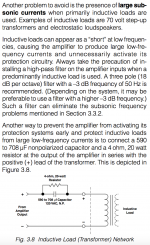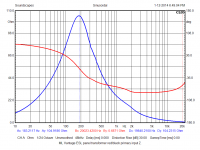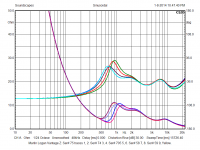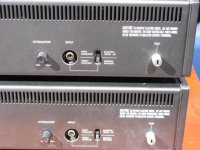Some vintage Luxman power amplifiers (and also maybe an occasional rebrand like the Eumig M-1000) had a two-position switch on the back for ESL speakers, next to the input. One side of the switch would say: "INPUT CAPACITOR / ELECTROSTATIC SPEAKER" and the other "DIRECT COUPLING / GENERAL SPEAKER". See attached.
Now as a non-EE guy, I'm trying to tease out what this switch was actually doing. Luxman M-05 on thevintageknob.org - a page about a different amp - describes outputs with Zobel networks "for stability into reactive loads", but it's not clear to me that that's what's going on with the switch next to the inputs.
Any ideas? Schematic attached. I assume SW02 is the switch we're looking for, but I could be wrong.
Now as a non-EE guy, I'm trying to tease out what this switch was actually doing. Luxman M-05 on thevintageknob.org - a page about a different amp - describes outputs with Zobel networks "for stability into reactive loads", but it's not clear to me that that's what's going on with the switch next to the inputs.
Any ideas? Schematic attached. I assume SW02 is the switch we're looking for, but I could be wrong.
Attachments
Looks like nothing more than a DC blocking capacitor, it would also limit subsonic signal content to some degree. (I did not calculate the -3dB LF corner so no idea how effective this is.)
The transformers in many electrostatic speakers are not designed to deal with significant DC current and likely very low frequencies either, so this switch would make life a little easier for the transformer and likely the amp as well since transformer primary DCR should be quite low compared to the DCR of a typical speaker voice coil which could result in significant DC output current if there was some DC on the output of the pre-amp.
The transformers in many electrostatic speakers are not designed to deal with significant DC current and likely very low frequencies either, so this switch would make life a little easier for the transformer and likely the amp as well since transformer primary DCR should be quite low compared to the DCR of a typical speaker voice coil which could result in significant DC output current if there was some DC on the output of the pre-amp.
Hi Altie:
Electrostatic loudspeakers use a transformer to multiply the voltage from the amplifier to the level required by the stators. Some early designs had no capacitance in series with this transformer, which resulted in a very low impedance presented to the amplifier at frequencies far lower than the loudspeaker could reproduce. With the right source material (such as VLF rumble from a turntable), a direct coupled amp could be damaged or at least sound bad. HiFi amps often don't have the protection circuity required to handle such abuse, so damage was more likely.
Here's an explanation from the manual of another DC capable amp, the Crown DC300A II:

Here's the input impedance of a Martin Logan Vantage electrostatic where I bypassed the passive crossover and measured the transformer directly. Blue is impedance, red is phase:

Here is the same measurement (but of 5 different loudspeakers) with the passive crossover in circuit. The lower traces are impedance, the upper are phase. This is the actual load the amplifier sees per Martin Logan's design. You would not need to insert the high pass capacitor with that switch on the back of your amp for this or most other modern electrostatics:

Very low impedance at high frequencies is something you're stuck with when using electrostatics and makes for a very amplifier specific sound. Tube amps particularly tend to sound soft at HF due to their high output impedance (another way of saying low damping factor).
Electrostatic loudspeakers use a transformer to multiply the voltage from the amplifier to the level required by the stators. Some early designs had no capacitance in series with this transformer, which resulted in a very low impedance presented to the amplifier at frequencies far lower than the loudspeaker could reproduce. With the right source material (such as VLF rumble from a turntable), a direct coupled amp could be damaged or at least sound bad. HiFi amps often don't have the protection circuity required to handle such abuse, so damage was more likely.
Here's an explanation from the manual of another DC capable amp, the Crown DC300A II:

Here's the input impedance of a Martin Logan Vantage electrostatic where I bypassed the passive crossover and measured the transformer directly. Blue is impedance, red is phase:

Here is the same measurement (but of 5 different loudspeakers) with the passive crossover in circuit. The lower traces are impedance, the upper are phase. This is the actual load the amplifier sees per Martin Logan's design. You would not need to insert the high pass capacitor with that switch on the back of your amp for this or most other modern electrostatics:

Very low impedance at high frequencies is something you're stuck with when using electrostatics and makes for a very amplifier specific sound. Tube amps particularly tend to sound soft at HF due to their high output impedance (another way of saying low damping factor).
Thanks all, that is excellent info. I was under the now clearly mistaken impression that these vintage amps I was looking at were suitable for direct drive. It seems pretty obvious in retrospect that that wouldn't be the case given that they're solid state and that based on some other 5-15 year old threads I've read around here, generating voltages necessary for ESL direct drive is still a challenge (not impossible, but a challenge) for modern solid state devices.
That moves me onto the question of how much discernable audio quality is on the table by either upgrading transformers, or moving to proper direct drive. The panels and circuitry in question are: JANSZEN ELECTROSTATIC PANEL TUBE POWER AMPLIFIER MIDRANGE TWEETER HF SPEAKERS | eBay - although the auction says Janszen, they appear the same as the ones used in the RTR ESR series - RTR ESR-6 or RTR ESR-15: RTR ESR-15 - Manual - Electrostatic Loudspeaker System - HiFi Engine. I guess I'm inclined to think that given their age there might be better options on the market or available to the intrepid DIYer these days, but I'm not sure of that.
That moves me onto the question of how much discernable audio quality is on the table by either upgrading transformers, or moving to proper direct drive. The panels and circuitry in question are: JANSZEN ELECTROSTATIC PANEL TUBE POWER AMPLIFIER MIDRANGE TWEETER HF SPEAKERS | eBay - although the auction says Janszen, they appear the same as the ones used in the RTR ESR series - RTR ESR-6 or RTR ESR-15: RTR ESR-15 - Manual - Electrostatic Loudspeaker System - HiFi Engine. I guess I'm inclined to think that given their age there might be better options on the market or available to the intrepid DIYer these days, but I'm not sure of that.
As I'm reading more it sounds like transformer distortion may be a total non-issue for a hybrid system crossed around, say, 1-2KHz. Oh well. Have to find something else to tweak 😉
Specifically, the graphs on page 10 of http://jensen-transformers.com/wp-content/uploads/2014/09/Audio-Transformers-Chapter.pdf seem to be saying that above, let's say, 200Hz with a low impedance voltage-source solid state amp, distortion should be tiny.
- Status
- Not open for further replies.
- Home
- Loudspeakers
- Planars & Exotics
- What was Luxman up to with the electrostatic speaker switch on their amps?
